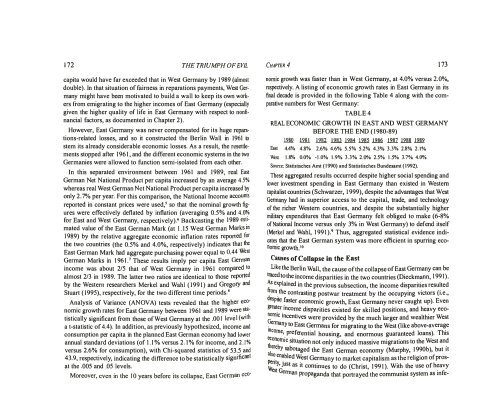austin-murphy-the-triumph-of-evil
austin-murphy-the-triumph-of-evil
austin-murphy-the-triumph-of-evil
You also want an ePaper? Increase the reach of your titles
YUMPU automatically turns print PDFs into web optimized ePapers that Google loves.
172 THE TRIUMPH OF EVIL<br />
capita would have far exceeded that in West Germany by 1989 (almost<br />
double). In that situation <strong>of</strong> fairness in reparations payments, West Ger·<br />
many might have been motivated to build a wall to keep its own work·<br />
ers from emigrating to <strong>the</strong> higher incomes <strong>of</strong> East Germany (especially<br />
given <strong>the</strong> higher quality <strong>of</strong> life in East Germany with respect to nonfi·<br />
nancial factors, as documented in Chapter 2).<br />
However, East Germany was never compensated for its huge repara·<br />
tions-related losses, and so it constructed <strong>the</strong> Berlin Wall in 1961 to<br />
stem its already considerable economic losses. As a result, <strong>the</strong> resettle·<br />
ments stopped after 1961, and <strong>the</strong> different economic systems in <strong>the</strong> two<br />
Germanies were allowed to function semi-isolated from each o<strong>the</strong>r.<br />
In this separated environment between 1961 and 1989, real East<br />
German Net National Product per capita increased by an average 4.5%<br />
whereas real West German Net National Product per capita increased by<br />
only 2.7% per year. For this comparison, <strong>the</strong> National Income accounts<br />
reported in constant prices were used,5 so that <strong>the</strong> nominal growth fig·<br />
ures were effectively deflated by inflation (averaging 0.5% and 4.0%<br />
fo r East and West Germany, respectively).6 Backcasting <strong>the</strong> 1989 esti·<br />
mated value <strong>of</strong> <strong>the</strong> East German Mark (at 1.15 West German Marks in<br />
1989) by <strong>the</strong> relative aggregate economic inflation rates reported for<br />
<strong>the</strong> two countries (<strong>the</strong> 0.5% and 4.0%, respectively) indicates that <strong>the</strong><br />
East German Mark had aggregate purchasing power equal to 0.44 West<br />
German Marks in 1961.7 These results imply per capita East German<br />
income was about 2/5 that <strong>of</strong> West Germany in 1961 compared to<br />
almost 2/3 in 1989. The latter two ratios are identical to those reported<br />
by <strong>the</strong> Western researchers Merkel and Wahl ( 1991) and Gregory and<br />
Stuart ( 1995), respectively, for <strong>the</strong> two different time periods. 8<br />
Analysis <strong>of</strong> Variance (ANOVA) tests revealed that <strong>the</strong> higher eco·<br />
nomic growth rates fo r East Germany between 1961 and 1989 were sta·<br />
tistically significant from those <strong>of</strong> West Germany at <strong>the</strong> .00 I level (with<br />
a t-statistic <strong>of</strong> 4.4). In addition, as previously hypo<strong>the</strong>sized, income and<br />
consumption per capita in <strong>the</strong> planned East German economy had lower<br />
annual standard deviations (<strong>of</strong> 1.1% versus 2. 1% for income, and 2.1%<br />
versus 2.6% for consumption), with Chi-squared statistics <strong>of</strong> 53.5 and<br />
43.9, respectively, indicating <strong>the</strong> difference to be statistically significant<br />
at <strong>the</strong> .005 and .05 levels.<br />
Moreover, even in <strong>the</strong> I 0 years before its collapse, East German eco·<br />
CHAPTER 4 173<br />
nomic growth was faster than in West Germany, at 4.0% versus 2.0%,<br />
respectively. A listing <strong>of</strong> economic growth rates in East Germany in its<br />
final decade is provided in <strong>the</strong> fo llowing Table 4 along with <strong>the</strong> comparative<br />
numbers for West Germany:<br />
TABLE 4<br />
REAL ECONOMIC GROWTH IN EAST AND WEST GERMANY<br />
BEFORE THE END (1980-89)<br />
.l.28Q .l.lli .1.2R2 .l2B.l 12M .l2B.i .1.2.82 .1281 � .1.28.2<br />
East 4.4% 4.8% 2.6% 4.6% 5.5% 5.2% 4.3% 3.3% 2.8% 2. 1%<br />
West 1.8% 0.0% -1.0% 1.9% 3.3% 2.00/o 2.5% 1.5% 3.7% 4.0%<br />
Source: Statistisches Amt ( 1990) and Statistisches Bundesamt ( 1992).<br />
These aggregated results occurred despite higher social spending and<br />
lower investment spending in East Germany than existed in Western<br />
capitalist countries (Schwarzer, 1999), despite <strong>the</strong> advantages that West<br />
Gennany had in superior access to <strong>the</strong> capital, trade, and technology<br />
<strong>of</strong> <strong>the</strong> richer Western countries, and despite <strong>the</strong> substantially higher<br />
military expenditures that East Germany felt obliged to make (6-8%<br />
<strong>of</strong> National Income versus only 3% in West Germany) to defend itself<br />
(Merkel and Wahl, 1991).9 Thus, aggregated statistical evidence indicates<br />
that <strong>the</strong> East German system was more efficient in spurring economic<br />
growtb.1o<br />
Causes <strong>of</strong> Collapse in <strong>the</strong> East<br />
Like <strong>the</strong> Berlin Wall, <strong>the</strong> cause <strong>of</strong> <strong>the</strong> collapse <strong>of</strong> East Germany can be<br />
traced to <strong>the</strong> income disparities in <strong>the</strong> two countries (Dieckmann, 1991 ) .<br />
As explained in <strong>the</strong> previous subsection, <strong>the</strong> income disparities resulted<br />
:om . <strong>the</strong> contrasting postwar treatment by <strong>the</strong> occupying victors (i.e.,<br />
esp•te �aster economic growth, East Germany never caught up). Even<br />
&realer mcome disparities existed for skilled positions, and heavy ceono<br />
ffilc · mcenhves · ·<br />
.<br />
were provided by <strong>the</strong> much larger and wealthter West<br />
�ermany to East Germans for migrating to <strong>the</strong> West (like above-average<br />
IDcome, preferential<br />
. housing, and enormous guaranteed loans). This<br />
econom•c situation not only induced massive migrations to <strong>the</strong> West and<br />
<strong>the</strong>reby<br />
sabota b) b ·<br />
a 1 � en�bled West Germany to market capitalism as <strong>the</strong> religion <strong>of</strong> pros<br />
�ty, Just as it continues to do (Christ, 1991). With <strong>the</strong> use <strong>of</strong> heavy<br />
ged <strong>the</strong> East German economy (Murphy, 1990 , ut tt<br />
est German propaganda that portrayed <strong>the</strong> communist system as infe-


